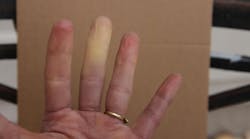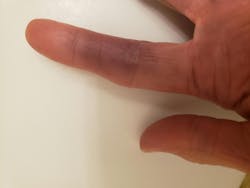As I scrubbed my skillet in the kitchen sink, I suddenly felt a sharp pain followed by an itchy sensation in the palm of my hand; it almost felt like something had popped under my skin. When I looked at my palm, I noticed a strange, purplish patch where the sensation had been. It looked like blood pooling under the skin.
I didn’t think I’d injured myself while doing the dishes, so I thought it might’ve been one of those random, fleeting pains I get from time to time. Although I initially dismissed the incident, I started to worry when it happened several months later in the volar aspect of my ring finger. Although it wasn’t that painful, what if it was symptom of something more serious? Atherosclerosis? Leukemia? Some horrible unknown disease?
I immediately Googled my symptoms: pain, itching, and subcutaneous bruising in palm of hand. As I sifted through the search results, I came across Achenbach syndrome, which described my condition perfectly.
Achenbach syndrome
Achenbach’s is a rare but benign, self-limiting disorder, also known as “paroxysmal finger hematoma.”1 Diagnosis is solely clinical and is based on the sudden onset of pain and blue/purplish-red discoloration of one or more fingers on the volar surface or on the palm of the hand. Typically, it resolves within a few hours to a couple days on its own without treatment.1,2
First introduced by German physician Walter Achenbach in 1958, this is an uncommon condition that is often initially treated as an emergency of suspected traumatic, ischemic, or hematological causes. However, patients do not usually report any trauma—their blood tests for coagulation and thrombophilia come back nagative.2 While the exact cause remains unknown, this condition is linked to genetics and predominantly affects women over the age of 50.3
As someone with Achenbach syndrome, I continue to experience these sudden subcutaneous bleeds about three or four times a year. While nettlesome, this condition has thankfully not affected my ability to work as a dental hygienist. However, I would soon come to find this was not the only hand-related condition I had.
Raynaud’s disease
I remember standing outside my grammar school in the freezing cold as a child, waiting to be let inside. I was amazed that other children could laugh and play without mittens. How could they be so unaffected when I was on the verge of tears from the pain in my fingers due to the cold?
I have since discovered that my father, my sister, and I suffer from a condition called Raynaud’s (pronounced Ray-NOSE) disease, a common disorder affecting about one in 20 people.4
Raynaud’s affects the fingers and sometimes the toes, causing the smaller arteries that supply blood to the skin to narrow. This limited blood flow results in tingling, numbness, pain, and whiteness of the extremities. Like Achenbach’s, this condition tends to affect women more than men. Its onset typically occurs between the ages of 15 and 30 and is more common in people who live in colder climates.4
There are two types of Raynaud’s disease: primary and secondary. The cause of primary Raynaud’s is unknown but often runs in families. Unlike secondary Raynaud’s, it is not linked to any underlying diseases and is usually controlled by lifestyle changes.4
Secondary Raynaud's on the other hand, may be treated with medication. In addition to carpal tunnel syndrome, repeated actions and exposure to vibrations are risk factors for this condition.
I have primary Raynaud’s, which means I always protect my hands in the cold and carry a pair of cheap gloves in my pocket for trips to the grocery store. I put them on when handling frozen foods. Since my toes are also affected, I wear thick socks to work in the winter.
De Quervain tenosynovitis
Since bad things often come in threes, my third hand condition is something called De Quervain tenosynovitis. While at work, I noticed pain in my thumb and wrist of my left hand while retracting a patient’s cheek with my mouth mirror. Initial X-rays of my hand and wrist came back inconclusive, so my doctor sent me to a rheumatologist.
Sitting in the waiting room made me anxious; I was afraid of being diagnosed with something serious—something that might end my career. When the doctor entered the room, I was able to relax because he reminded me of my son. Dr. Wu spoke quietly and listened attentively, radiating kindness and gentleness. After explaining my symptoms, he moved my left hand and fingers into different positions. Although this didn’t hurt, I yelped in excruciating pain when he quickly turned my wrist. Doing this was the Finkelstein test—the classic way to diagnose De Quervain tenosynovitis.
This painful condition affects the tendons on the thumb-side of the wrist. Like the other two hand conditions, its cause is unknown and affects more women than men.5 It worsens with activities that rely on repetitive hand or wrist movements such as golf, racket sports, gardening, and lifting a baby.5 Because of this, it is sometimes referred to as “mother’s wrist” and is common both during and after pregnancy. One can also assume it worsens with the repetitive hand/wrist movements of cleaning patients’ teeth.
As treatment, Dr. Wu injected a corticosteroid into the tendon and provided me with an ugly, bulky brace. Although it prevented me from hurting my wrist, I had to modify the way I moved my left hand to work efficiently. For me, the pain was worse in the morning, so I wore the brace at night for more than a year. Despite Dr. Wu’s recommendation to quit dental hygiene, I am still pain-free and able to work 10 years later. Even so, I still have that ugly wrist brace just in case I need it.
Conclusion
As dental hygienists, our hands and wrists can take a beating, which is why we need to be proactive in preventing injuries by using appropriate instruments and ergonomics. That said, conditions can still arise for no apparent reason. If that is the case, don’t just Google your symptoms—get a diagnosis from a doctor.
I have been lucky to work for 46 years despite my trifecta of hand problems. There may come a day when my hands make it clear that they’ve had enough, but until that day comes, I will continue to do what I love.
References
1. Chiriac A, Wollina U, Miulescu R, et al. Achenbach syndrome – case report and discussion on the interdisciplinary approach of a patient. Maedica (Bucur). 2022;17(3):740-742. doi:10.26574/maedica.2022.17.3.740
2. Harnarayan P, Ramdass MJ, Islam S, Naraynsingh V. Achenbach’s syndrome revisited: the paroxysmal finger hematoma may have a genetic link. Vasc Health Risk Manag. 2021;17:809-816. doi:10.2147/VHRM.S342847
3. Gomes JF, Mendes J, Donaire D, Ferreira M. Achenbach’s syndrome. BMJ Case Rep. 2020;13(9):e238156. doi:10.1136/bcr-2020-238156
4. Raynaud’s disease. Mayo Clinic. November 2022. https://www.mayoclinic.org/diseases-conditions/raynauds-disease/symptoms-causes/syc-20363571
5. De Quervain tenosynovitis. Mayo Clinic. August 2022. https://www.mayoclinic.org/diseases-conditions/de-quervain-tenosynovitis/symptoms-causes/syc-20371332
Kirsten Brancheau, BA, RDH, has been practicing clinical dental hygiene since 1978. She earned an associate’s degree in applied science in dental hygiene from Union County College in 1977 and a bachelor of arts degree in English literature from Montclair State University in 1988. She is a member of the American Dental Hygienists’ Association. Brancheau is also a freelance proofreader, editor, and writer. She can be reached at [email protected].









